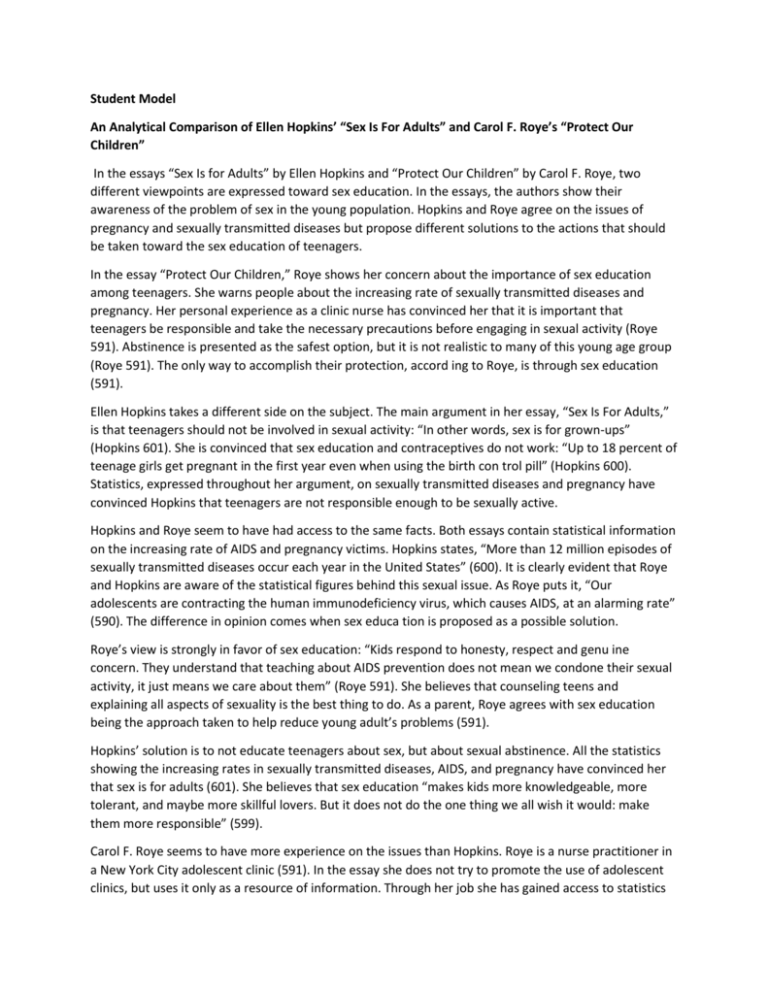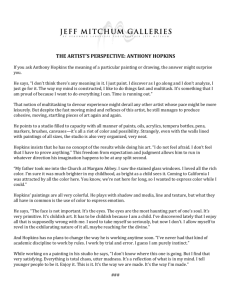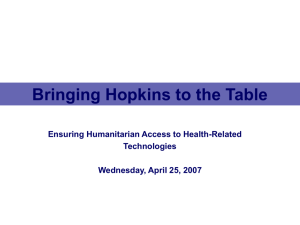
Student Model
An Analytical Comparison of Ellen Hopkins’ “Sex Is For Adults” and Carol F. Roye’s “Protect Our
Children”
In the essays “Sex Is for Adults” by Ellen Hopkins and “Protect Our Children” by Carol F. Roye, two
different viewpoints are expressed toward sex education. In the essays, the authors show their
awareness of the problem of sex in the young population. Hopkins and Roye agree on the issues of
pregnancy and sexually transmitted diseases but propose different solutions to the actions that should
be taken toward the sex education of teenagers.
In the essay “Protect Our Children,” Roye shows her concern about the importance of sex education
among teenagers. She warns people about the increasing rate of sexually transmitted diseases and
pregnancy. Her personal experience as a clinic nurse has convinced her that it is important that
teenagers be responsible and take the necessary precautions before engaging in sexual activity (Roye
591). Abstinence is presented as the safest option, but it is not realistic to many of this young age group
(Roye 591). The only way to accomplish their protection, accord ing to Roye, is through sex education
(591).
Ellen Hopkins takes a different side on the subject. The main argument in her essay, “Sex Is For Adults,”
is that teenagers should not be involved in sexual activity: “In other words, sex is for grown-ups”
(Hopkins 601). She is convinced that sex education and contraceptives do not work: “Up to 18 percent of
teenage girls get pregnant in the first year even when using the birth con trol pill” (Hopkins 600).
Statistics, expressed throughout her argument, on sexually transmitted diseases and pregnancy have
convinced Hopkins that teenagers are not responsible enough to be sexually active.
Hopkins and Roye seem to have had access to the same facts. Both essays contain statistical information
on the increasing rate of AIDS and pregnancy victims. Hopkins states, “More than 12 million episodes of
sexually transmitted diseases occur each year in the United States” (600). It is clearly evident that Roye
and Hopkins are aware of the statistical figures behind this sexual issue. As Roye puts it, “Our
adolescents are contracting the human immunodeficiency virus, which causes AIDS, at an alarming rate”
(590). The difference in opinion comes when sex educa tion is proposed as a possible solution.
Roye’s view is strongly in favor of sex education: “Kids respond to honesty, respect and genu ine
concern. They understand that teaching about AIDS prevention does not mean we condone their sexual
activity, it just means we care about them” (Roye 591). She believes that counseling teens and
explaining all aspects of sexuality is the best thing to do. As a parent, Roye agrees with sex education
being the approach taken to help reduce young adult’s problems (591).
Hopkins’ solution is to not educate teenagers about sex, but about sexual abstinence. All the statistics
showing the increasing rates in sexually transmitted diseases, AIDS, and pregnancy have convinced her
that sex is for adults (601). She believes that sex education “makes kids more knowledgeable, more
tolerant, and maybe more skillful lovers. But it does not do the one thing we all wish it would: make
them more responsible” (599).
Carol F. Roye seems to have more experience on the issues than Hopkins. Roye is a nurse practitioner in
a New York City adolescent clinic (591). In the essay she does not try to promote the use of adolescent
clinics, but uses it only as a resource of information. Through her job she has gained access to statistics
and has acquired information through one-on-one encounters with teenagers and their problems (591).
Her direct exposure allows her to find out first hand what teenagers think and need when it comes to
sex (591). It makes her more aware of the problem and of solutions that have already worked (591).
With this in mind she is able to present a more complete topic.
Ellen Hopkins draws a more statistically based conclusion than that of Roye: “Even if sex education
worked, birth control doesn’t . . . 36 percent of women get pregnant while relying on male use of
condoms” (600). Hopkins’ conclusion is distorted based more on the faulti ness of contraceptives and
190 GUIDE TO FRESHMAN COMPOSITION the figures on teenagers that have fallen victims to AIDS and
pregnancy rather than the faults of sex education. Her conclusion becomes unrealistic when she says
that teenagers should not have sex, based on the assumption that sex education encourages them to
have sex (Hopkins 599).
It is obvious that a problem exists when it comes to teenagers and sex. In the essays, “Protect Our
Children” by Carol F. Roye and “Sex Is For Adults” by Ellen Hopkins, education of teen agers on facts
about sex is the issue. The authors discuss similar evidence but propose opposite solutions. While
Hopkins believes in abstinence, Roye believes in educating teenagers with facts. I believe that the
strongest argument is proposed by Roye. She shows to be more aware of the reality that teenagers are
not going to stop their sexual activity and that they are better off being aware of the consequences and
the proper precautions.
Works Cited
Hopkins, Ellen. “Sex Is For Adults.” Elements of Argument. Ed. Annette T. Rottenberg. 3rd ed. New York:
Bedford Books, 1994. 599–601. Print.
Roye, Carol F. “Protect Our Children.” Elements of Argument. Ed. Annette T. Rottenberg. 3rd ed. New
York: Bedford Books, 1994. 590–91. Print.
Omar Madrid
http://www.english.msstate.edu/comp/compmaterials/2011_Comparative_Analysis.pdf








